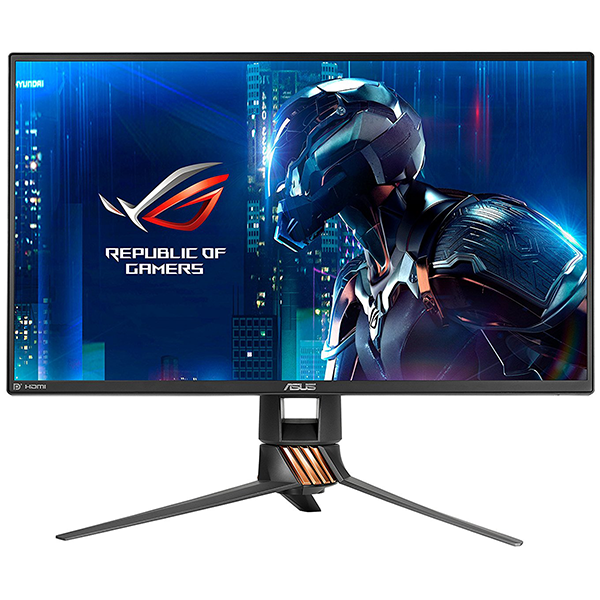Acer Predator Z301CT Monitor Review
Why you can trust Tom's Hardware
Brightness & Contrast
To read about our monitor tests in depth, please check out Display Testing Explained: How We Test Monitors and TVs. Brightness and Contrast testing is covered on page two.
Uncalibrated – Maximum Backlight Level
We’ve included a mix of ultra-wide gaming screens along with Asus’ PG258Q, which is the fastest monitor we’ve tested to date. We've also included Acer’s XR382CQK, LG’s 38UC99 and 34UC79G, and Asus’ PG348Q. All support either G-Sync or FreeSync, have high refresh rates, and are premium-priced.
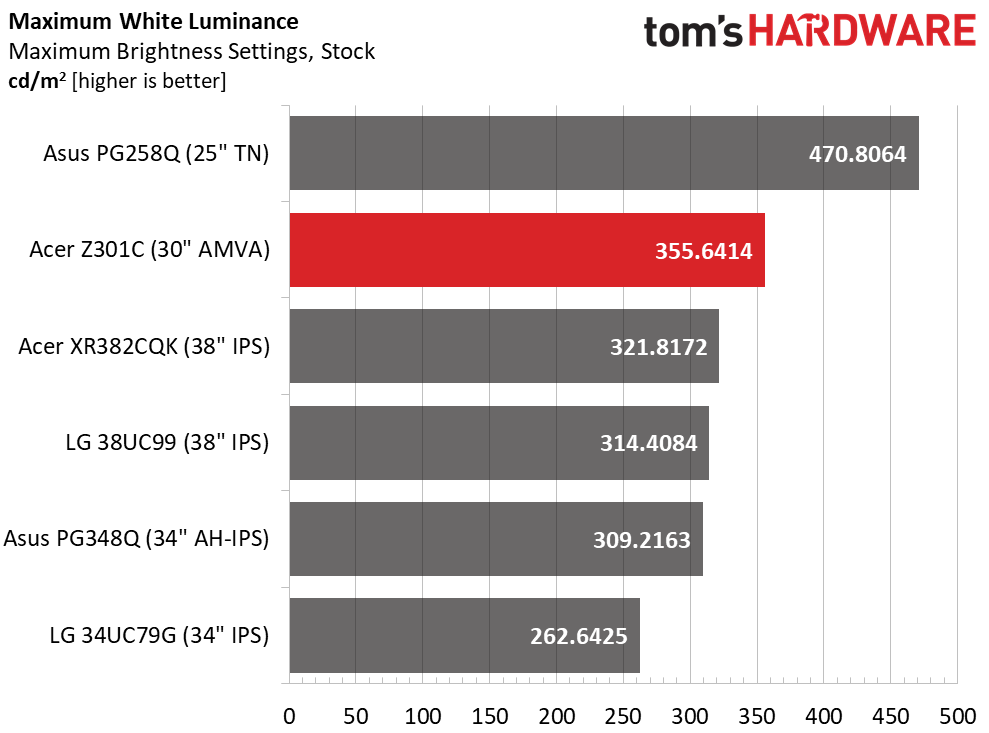
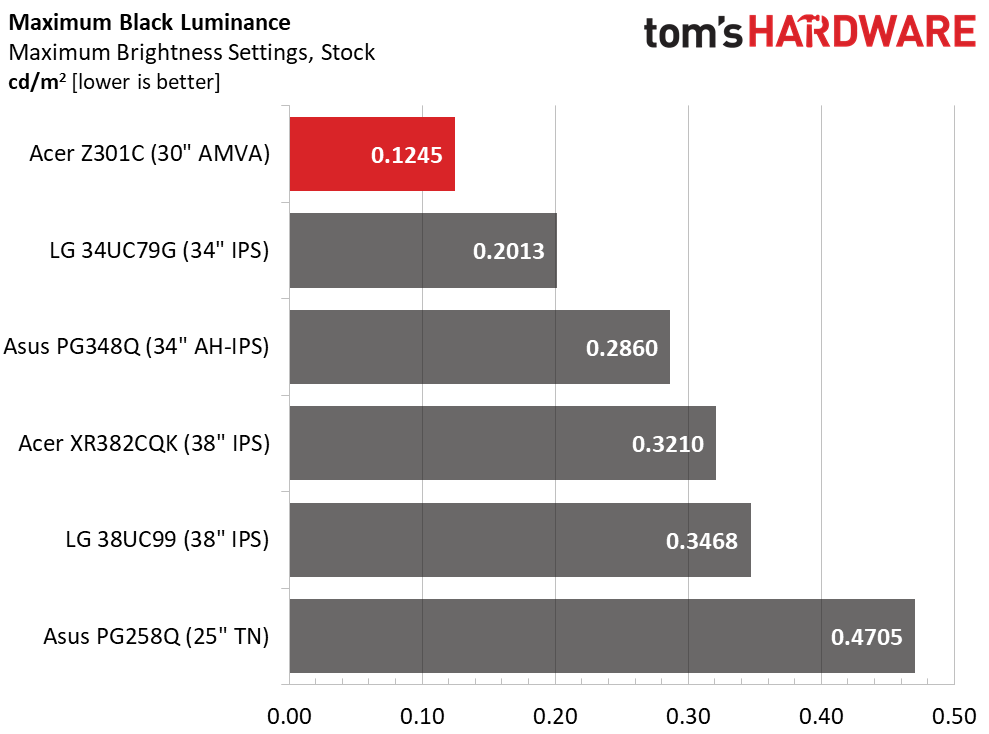
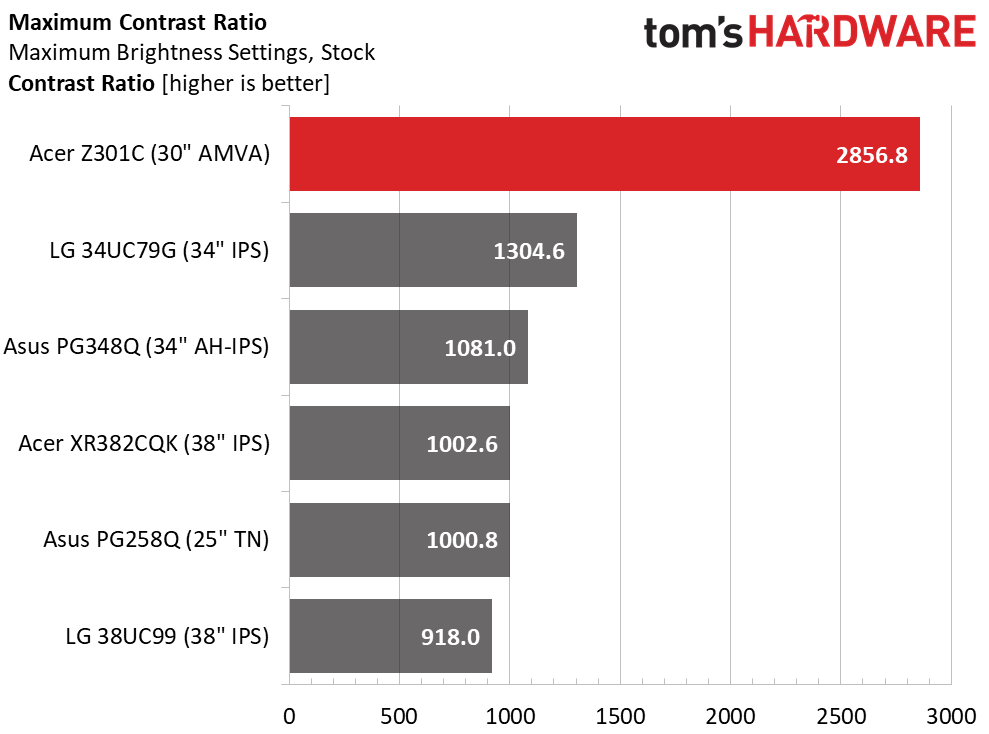
Acer claims 300cd/m2 for the Z301CT, which is a little low for effective ULMB performance. Luckily, our sample exceeded that with a 355.6144cd/m2 measurement allowing for a little more headroom. Being the only VA panel in the group made the black level and contrast tests an easy win for Acer. With nearly 3000:1 and the inkiest blacks this side of a plasma panel, image depth doesn’t get much better than this. And it’s completely worth giving up some pixel density.
Uncalibrated – Minimum Backlight Level
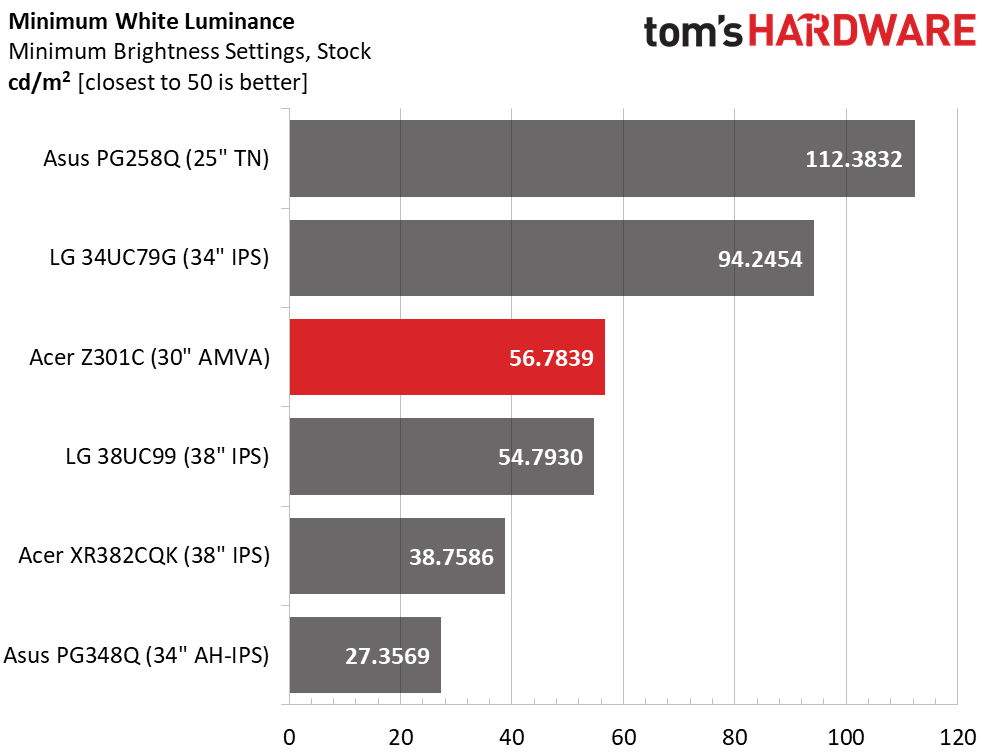

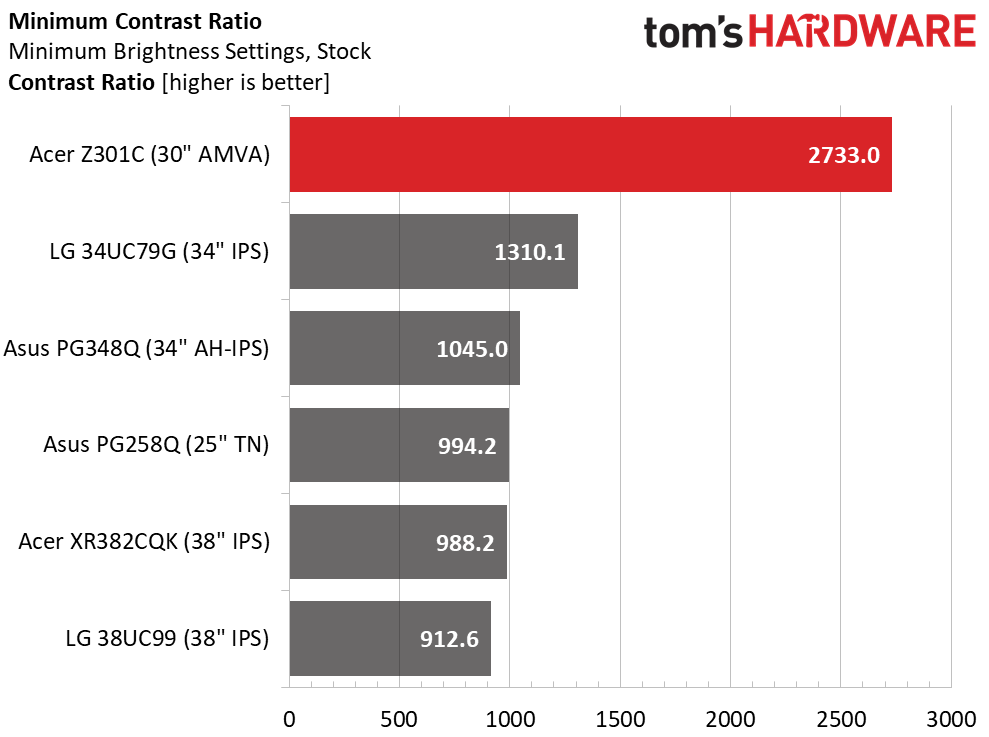
The minimum white level is a comfortable 56.7839cd/m2 with the brightness control on zero. That’s a great way to play in a dark room. And with no reduction in contrast, the image still has all the pop seen at higher brightness. The black level is low enough that you can barely tell the Z301CT is turned on. If there is any ambient light present, you won’t see any glow from the backlight at all.
After Calibration to 200cd/m2


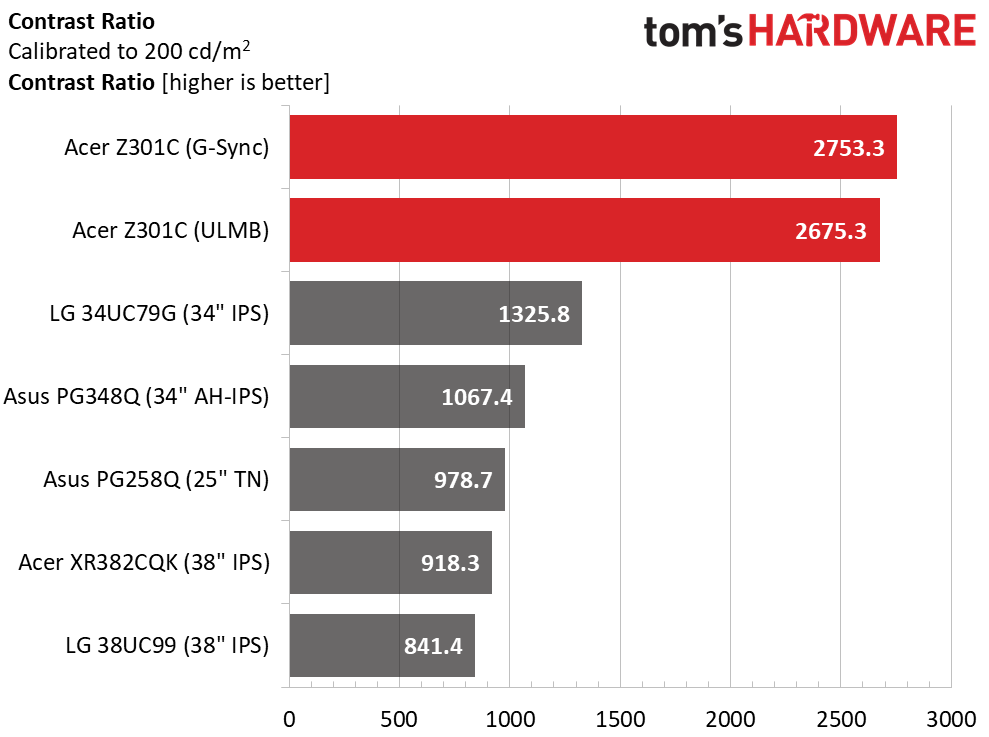
We were concerned that the Z301CT’s too-high contrast setting might mean a loss of contrast after calibration. Clearly this is not the case. We gave up nothing even after reducing the slider eight clicks. And check out those ULMB numbers. Yes, there is a 50% output loss, but contrast is practically unchanged. This is a huge step forward for the technology. With most G-Sync monitors, we’d recommend avoiding the backlight strobe because it robs the picture’s dynamic range. But it's not a problem here; it’s a truly usable feature. If you don’t have a G-Sync-capable video card, you can still enjoy a large reduction in motion blur with ULMB. Just max the backlight so you have enough brightness to work with.
ANSI Contrast Ratio
The difference between the Z301CT’s sequential and ANSI contrast results seems large, but in practice, it’s not a big deal. Our sample has good uniformity, but a little extra brightness in the black squares on the bottom of the screen lowered our result a bit. It’s still quite a bit higher than the others, and that is demonstrated in real-world content.
MORE: Best Gaming Monitors
Get Tom's Hardware's best news and in-depth reviews, straight to your inbox.
MORE: Best Professional Monitors
MORE: How We Test Monitors
MORE: How To Choose A Monitor
Current page: Brightness & Contrast
Prev Page OSD & Calibration, Tobii Eye-Tracking Setup Next Page Grayscale, Gamma & Color
Christian Eberle is a Contributing Editor for Tom's Hardware US. He's a veteran reviewer of A/V equipment, specializing in monitors. Christian began his obsession with tech when he built his first PC in 1991, a 286 running DOS 3.0 at a blazing 12MHz. In 2006, he undertook training from the Imaging Science Foundation in video calibration and testing and thus started a passion for precise imaging that persists to this day. He is also a professional musician with a degree from the New England Conservatory as a classical bassoonist which he used to good effect as a performer with the West Point Army Band from 1987 to 2013. He enjoys watching movies and listening to high-end audio in his custom-built home theater and can be seen riding trails near his home on a race-ready ICE VTX recumbent trike. Christian enjoys the endless summer in Florida where he lives with his wife and Chihuahua and plays with orchestras around the state.
-
lazymangaka 2560x1080 is the perfect resolution for most people who aren't gaming on absolute top-end hardware. My GTX 1060 runs absolutely everything at it just fine, with some room even for supersampling. I would certainly imagine that higher ultrawide resolutions would require real compromises with mainstream hardware.Reply -
Larmo-Ct Approximately eight plus years ago. I bought a Gateway 30 inch monitor. In those days it was hard to find a popular brand that made monitors that large. In my opinion it has taken a number of years for more companies to add 30" monitors to their inventories. It has been comparatively easy to purchase 24" and 27" monitors for years. As those sizes have become more popular, the prices have dropped consistently.Reply
In the past month, I purchased a Dell UP3216Q, directly from Dell for $1399.00,
( down from $1700.00 ) before tax and shipping. That model is a 32" monitor with
maximum resolution of 3840x2160 at 60hz. Aside from the Gateway 30", I have purchased a Dell 30" monitor, ( which died after about 4+ years ), and an HP 30" monitor ( which is along side my 32" as I write this ). I am certainly not wealthy, and don't play a lot of FPS games, ( I prefer real world simulations like Steel Beast Pro Armored vehicle/combined arms ). I have always enjoyed working, and playing, using my large monitors.
Lastly, I have to wonder at the calculations folks have used in this forum. Regarding the price of monitors like the Acer Predator Z301C. They have mentioned things like base price, plus the estimated cost of including various features. That is all well and good, but I don't think they have factored in a couple of intangibles. Companies maximizing their profit margin on any item. Also, the consumer base for large monitors is still rather small. People like Day Traders that use monitors in their businesses, and gamers. Are at this time, the only people that are willing to purchase anything that costs more than the current offerings of 24" and 27" monitors. So.., the scarcer an item is, the more it's going to cost. This has always been true of niche products.
Larmo-CT. -
ddferrari Show me a curved 34" 3440x1440p, IPS, G-sync, 100 fps monitor that isn't plagued with defects like the Predator X34, or has cheesy styling like the Asus p348q, and I'll take it. Oh, And I want it for a $1000.Reply -
Randy_86 So glad to see a manufacturer stepping away from the 4k fad. My friend and I couldn't tell a difference on a 32" monitor at normal gaming distance, so why make monitors with that level of resolution other than marketing? 4K stinks for gaming on any rig without $1200+ in graphics cards. 2560x1080 is GREAT. I only wish it were 2560 x 1200.Reply

